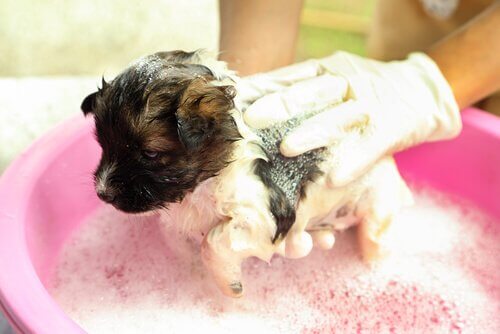All About Ehlers-Danlos Syndrome in Dogs

It may not be a well-known disease, but Ehlers-Danlos syndrome affects thousands of dogs all over the world. It affects the skin, so that when you touch it, it doesn’t return to its original shape. This can trigger very unpleasant consequences for your dog.
What is Ehlers-Danlos Syndrome?

Ehlers-Danlos syndrome is a hereditary disease caused by a decrease in collagen levels. Collagen is the main component which gives skin its elasticity. Because of this, if there’s no collagen, or if it’s defective, the skin won’t go back to its original position when you pull on it.
In addition, a lack of collagen in the skin makes it fragile and it can tear easily. This makes socialization with other dogs difficult, because a dog with this condition could get hurt while playing with them.
On the positive side, wounds heal faster with this syndrome. However, the scars they leave are white, bloody, and ugly. Furthermore, dogs with Ehlers-Danlos syndrome have thin, dry, and brittle hair.
Other consequences
Collagen deformation in the animal’s skin can also damage other organs or body parts. For example, it increases joint laxity. There are changes in the joints, and this causes bigger problems in the long run.
In addition, in some cases it can affect a dog’s eyes. For example, there may be changes to the cornea or crystalline lens. However, each case is different.
How to improve your dog’s condition
Since it’s a hereditary disease, it has no cure. However, according to doctors, you can improve your dog’s health by giving him vitamin C and by taking preventative measures.
These measures are to avoid aggressive play with other animals, and if your dog gets injured, to treat him as soon as possible to prevent infections.
Other skin conditions in dogs
Ehlers-Danlos syndrome is just one of the many skin diseases that can afflict our pets. If you want to know whether your pet’s skin is in good condition, you should check it often, and go to the vet if you see any worrying changes.
These are the most common skin diseases in dogs:

- Flea bite allergies. This is one of the most common conditions, and it occurs very easily. Fleas are everywhere, and produce an almost unbearable itchy feeling. The dog will scratch desperately and make the area red and even worse.
- Fungi. Animals aren’t exempt from fungal infections. Besides their ugly appearance, they are contagious. For that reason you should treat them as soon as possible, and only touch your pet with gloves until the infection disappears.
- Scabies. This condition is caused by a mite that lives under the skin and lays eggs everywhere, which hatch and continue the process over again. This makes the hair fall out and creates a horrible itching sensation that can’t be relieved by scratching.
- Food allergies. Allergies to certain foods can cause changes in an animal’s skin. Although we might not think it’s that important, allergies can cause serious problems in dogs. Go to the vet if you see any signs that this may be the case.
- Pyoderma. A pus-forming bacteria causes this common condition. This bacterium lodges in the anus, nasal orifices, or even in the animal’s face. The symptoms are visible, so treating it in time shouldn’t be a problem. The symptoms are skin eruptions, itching, scabs, and weight loss, among others.